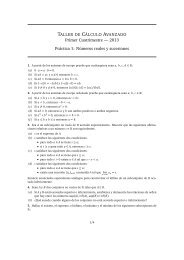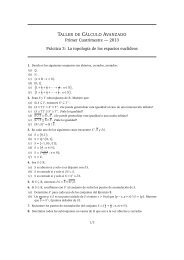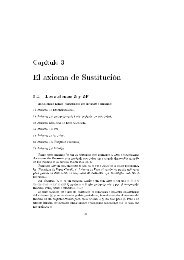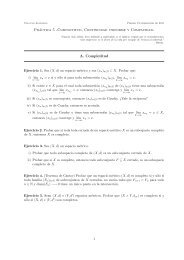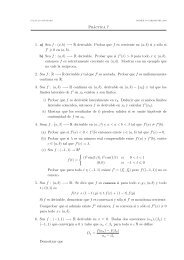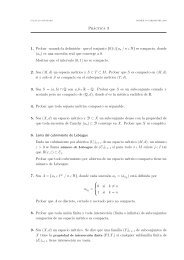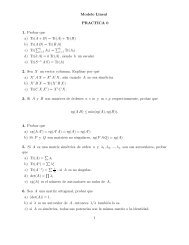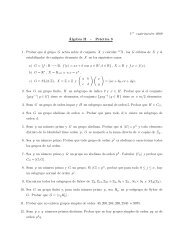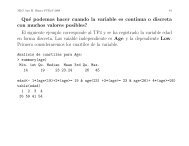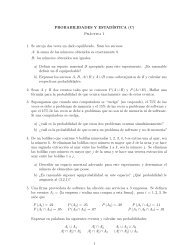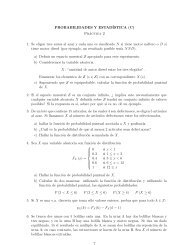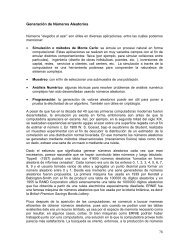Respuestas a algunos ejercicios de las prácticas
Respuestas a algunos ejercicios de las prácticas
Respuestas a algunos ejercicios de las prácticas
You also want an ePaper? Increase the reach of your titles
YUMPU automatically turns print PDFs into web optimized ePapers that Google loves.
Análisis Matemático I (Lic. en Cs. Biológicas)<br />
Primer cuatrimestre <strong>de</strong> 2009<br />
<strong>Respuestas</strong> a <strong>algunos</strong> <strong>ejercicios</strong> <strong>de</strong> <strong>las</strong> <strong>prácticas</strong><br />
Miguel Ottina<br />
Incluimos aquí <strong>las</strong> respuestas a <strong>algunos</strong> <strong>de</strong> los <strong>ejercicios</strong> <strong>de</strong> <strong>las</strong> guías. El objetivo es que el<br />
alumno pueda comprobar el resultado obtenido <strong>de</strong>spués <strong>de</strong> haber resuelto los <strong>ejercicios</strong>.<br />
Sin embargo, es muy importante aclarar que es posible llegar al resultado correcto incluso<br />
mediante argumentos erróneos, con lo cual la mera comprobación <strong>de</strong>l resultado no garantiza<br />
que la resolución sea correcta.<br />
Asimismo, cabe <strong>de</strong>stacar que en los exámenes se tendrá en cuenta principalmente la vali<strong>de</strong>z<br />
<strong>de</strong>l razonamiento, pero también el no haber cometido errores <strong>de</strong> cuentas en dicho <strong>de</strong>sarrollo.<br />
Periódicamente iremos actualizando este apunte incluyendo los resultados <strong>de</strong> los <strong>ejercicios</strong> <strong>de</strong><br />
<strong>las</strong> próximas <strong>prácticas</strong> y realizando <strong>las</strong> correcciones que sean necesarias.<br />
Quiero agra<strong>de</strong>cer especialmente a Inés Saltiva y a Georgina Giacobbe, quienes durante el<br />
segundo cuatrimestre <strong>de</strong> 2007 me brindaron una invaluable ayuda, sin la cual no hubiera sido<br />
posible la confección <strong>de</strong> estas respuestas en tiempo y forma.<br />
Práctica 1<br />
Ejercicio 1.<br />
(a) − 3<br />
2<br />
(b) 2<br />
3<br />
(c) 73<br />
5<br />
(d) 1 , 3<br />
Ejercicio 2.<br />
(a) [− 3<br />
2 ; +∞)<br />
(b) (−∞; 2<br />
3 )<br />
1/22<br />
(e) −10 , 10<br />
(f) 0 , 91<br />
15<br />
(g) 0 , 3<br />
(h) 5<br />
4<br />
(i) 2 , −2<br />
1√<br />
5<br />
− 313 ,<br />
4 4<br />
(c) (−1; − 3<br />
5 )<br />
(d) (−∞; − 7<br />
3 )<br />
1√<br />
+ 313<br />
4
Análisis Matemático I (Lic. en Cs. Biológicas) – Primer cuatrimestre <strong>de</strong> 2009 <strong>Respuestas</strong><br />
(e) (−∞; 4<br />
13 ]<br />
(f) (−∞; −4) ∪ (−2; +∞)<br />
(g) (−∞; − 7<br />
2 ] ∪ (2; +∞)<br />
(h) (− 1<br />
5 ; 0)<br />
(i) [2; 4]<br />
(j) (−∞; −13) ∪ (7; +∞)<br />
(k) (−∞; −1) ∪ ( 1<br />
3 ; +∞)<br />
(l) ∅<br />
Ejercicio 3.<br />
(a) [(−2; +∞)]<br />
(b) [− 3<br />
2 ; +∞)<br />
(c) [−2; 4]<br />
(d) [−3; 0)<br />
(e) ( 1<br />
3 , 1)<br />
(f) (−∞, − 3<br />
5 )<br />
(g) [− 3<br />
5 , +∞)<br />
(h) (−2, 0)<br />
(i) (−∞, −2) ∪ (0, +∞)<br />
(j) 0 , −5<br />
(k) −7 , 7<br />
Ejercicio 4.<br />
(a) f (0) = 1 , f ( 1 6<br />
3<br />
2 ) = 5 , f (2) = 5 .<br />
(b) f (a) =<br />
(c) [ f (x)] 2 =<br />
a + 1<br />
a 2 + 1 , g(a + 2) = (a + 2)3 − 1 .<br />
(x + 1)2<br />
(x2 , f (g(x)) =<br />
+ 1) 2<br />
(m) (−∞; −1)<br />
(n) (0; 1<br />
2 )<br />
(ñ) (−∞; − 3<br />
2<br />
(o) (−∞; − 1<br />
9<br />
(p) ∅<br />
1 ] ∪ [ 4 ; +∞)<br />
7 ) ∪ ( 9 ; +∞)<br />
(q) (−∞; 1) ∪ (3; +∞)<br />
(r) (−∞; 1) ∪ (3; +∞)<br />
(l) (−∞, −7) ∪ (7, +∞)<br />
(m) (−7, 7)<br />
(n) (−∞, −3) ∪ (7, +∞)<br />
(ñ) (−∞, − 7<br />
3 )<br />
(o) (−9, 0) ∪ (3, +∞)<br />
(p) (0, 2)<br />
(q) ( 5<br />
2 , +∞)<br />
(r) [1, +∞)<br />
(s) R<br />
(t) (−1, 0)<br />
(u) [1, 3√ 2]<br />
x3 (x3 − 1) 2 <br />
x + 1<br />
, g( f (x)) =<br />
+ 1 x2 3 − 1 .<br />
+ 1<br />
2/22
Análisis Matemático I (Lic. en Cs. Biológicas) – Primer cuatrimestre <strong>de</strong> 2009 <strong>Respuestas</strong><br />
Ejercicio 5.<br />
(a) R<br />
(b) (−∞, 3<br />
2 ]<br />
(c) (1, +∞)<br />
(d) R − {− 4<br />
3 }<br />
(e) R<br />
(f) R − {−3, −1}<br />
Ejercicio 6.<br />
Ejercicio 7.<br />
(a) Dom f = R , C0 = R , C+ = ∅ , C− = ∅ .<br />
(g) [0, +∞)<br />
(h) R<br />
(i) (−∞, − 1<br />
2<br />
(j) R<br />
1 ] ∪ [ 2 , +∞)<br />
(k) R − {−5, −2, 2}<br />
(l) R<br />
(b) Dom f = R , C0 = {0} , C+ = (0, +∞) , C− = (−∞, 0) .<br />
(c) Dom f = R , C0 = {0} , C+ = (−∞, 0) , C− = (0, +∞) .<br />
(d) Dom f = (−∞, 3] , C0 = {3} , C+ = (−∞, 3) , C− = ∅ .<br />
(e) Dom f = R − {−1, 3} , C0 = {− 1<br />
2 } , C+ = (−1, − 1<br />
2 ) ∪ (3, +∞) , C− = (−∞, −1) ∪ (− 1<br />
2<br />
(f) Dom f = R , C0 = {−1} , C+ = (−1, +∞) , C− = (−∞, −1) .<br />
(g) Dom f = R , C0 = { 1<br />
2 } , C+ = ( 1<br />
2 , +∞) , C− = (−∞, 1<br />
2<br />
(h) Dom f = R , C0 = {1, 3} , C+ = (1, 3) , C− = (−∞, 1) ∪ (3, +∞) .<br />
(i) Dom f = [−2, 2] , C0 = {−2, 2} , C+ = (−2, 2) , C− = ∅ .<br />
(j) Dom f = R , C0 = ∅ , C+ = R , C− = ∅ .<br />
(k) Dom f = R − {2} , C0 = ∅ , C+ = (2, +∞) , C− = (−∞, 2) .<br />
(l) Dom f = R − {−1} , C0 = {0} , C+ = (0, +∞) , C− = (−∞, −1) ∪ (−1, 0) .<br />
(m) Dom f = (−∞, 1] ∪ [2, +∞) , C0 = {1, 2} , C+ = (−∞, 1) ∪ (2, +∞) , C− = ∅ .<br />
(n) Dom f = [− 3<br />
2 , 0) ∪ (0, +∞) , C0 = {− 3<br />
2 } , C+ = (0, +∞) , C− = (− 3<br />
2 , 0) .<br />
3/22<br />
) .<br />
, 3) .
Análisis Matemático I (Lic. en Cs. Biológicas) – Primer cuatrimestre <strong>de</strong> 2009 <strong>Respuestas</strong><br />
Ejercicio 8.<br />
Ejercicio 9.<br />
Ejercicio 10.<br />
Ejercicio 11.<br />
(a) Dom f = R , Dom g = R − {−1} , Dom h = R .<br />
(b) F<br />
V<br />
(c) No existe (g ◦ f )(−1) .<br />
(d) f ◦ g =<br />
Ejercicio 12.<br />
( f ◦ h)(1) = 3 .<br />
1 2<br />
+<br />
(x + 1) 2 x + 1<br />
f ◦ h = (3x − 2) 2 + 6x − 4<br />
g ◦ f =<br />
1<br />
x 2 + 2x + 1<br />
F<br />
V<br />
(h ◦ f )(7) = 187 .<br />
( f ◦ g)(3) = 9<br />
16 .<br />
V<br />
V<br />
( f ◦ h)(7) = 399 .<br />
(g ◦ f )(6) = 1<br />
49 .<br />
f ◦ f = (x 2 + 2x) 2 + 2x 2 + 4x<br />
g ◦ h = 1<br />
3x − 1<br />
( f ◦ g) ◦ h =<br />
(a) Dom f = R , Im f = [−1/8, +∞) , no inyectiva, no sobreyectiva.<br />
(b) Dom f = [−2, +∞) , Im f = [0, +∞) , inyectiva, no sobreyectiva.<br />
(c) Dom f = R , Im f = R , inyectiva, sobreyectiva.<br />
(d) Dom f = R − {0} , Im f = R − {0} , inyectiva, no sobreyectiva.<br />
1 2<br />
+<br />
(3x − 1) 2 3x − 1<br />
(e) Dom f = (−∞, −3] ∪ [3, +∞) , Im f = [0, +∞) , no inyectiva, no sobreyectiva.<br />
(f) Dom f = R , Im f = [1, +∞) , no inyectiva, no sobreyectiva.<br />
Ejercicio 13.<br />
(a) f −1 (x) =<br />
Ejercicio 14.<br />
x + 5<br />
4 (b) f −1 <br />
x si x ≥ 0<br />
(x) =<br />
(a) Dom f = R − {0} , Im f = R − {0} , f −1 (x) = 1<br />
x .<br />
4/22<br />
1<br />
5 x si x < 0.
Análisis Matemático I (Lic. en Cs. Biológicas) – Primer cuatrimestre <strong>de</strong> 2009 <strong>Respuestas</strong><br />
(b) Dom f = R − {2} , Im f = R − {1} , f −1 (x) = 2x<br />
x − 1 .<br />
(c) Dom f = R − {1} , Im f = R − {3} , f −1 (x) = 3<br />
<br />
x<br />
x − 3 .<br />
Ejercicio 15.<br />
(a) Par.<br />
(b) Impar.<br />
Ejercicio 16.<br />
Ejercicio 17.<br />
Ejercicio 18.<br />
(c) Impar.<br />
(d) Nada.<br />
(e) Nada.<br />
(f) Nada.<br />
(a) C(x) = 22x + 20 don<strong>de</strong> x es la superficie cubierta medida en m 2 y C está en $ .<br />
(b) Dom C = [0, +∞) .<br />
(c) $284 .<br />
(d) Se pue<strong>de</strong>n colocar 20 m 2 <strong>de</strong> azulejos.<br />
Ejercicio 19.<br />
(a)<br />
(b) x = 6 o x = 5<br />
6 .<br />
Ejercicio 20.<br />
(a) Ascien<strong>de</strong> en [0, 600<br />
49<br />
(b) t = 600<br />
49<br />
, altura: 36000<br />
49 .<br />
(c) Demora 1200<br />
49 segundos.<br />
] . Descien<strong>de</strong> en [ 600<br />
49<br />
1200 , 49 ] .<br />
(d) h(t) = −4, 9t 2 + 120t + 50 . Ascien<strong>de</strong> en [0, 600<br />
49<br />
altura máxima es 38450<br />
49<br />
suelo.<br />
Ejercicio 21.<br />
(a) 0 < t < 7<br />
√<br />
1<br />
8 + 24 5241 .<br />
(b) La población se extingue a los 7 1<br />
8 + 24<br />
y la alcanza para t = 600<br />
49<br />
√ 5241 ∼ 3, 89 años.<br />
] . Descien<strong>de</strong> en [ 600<br />
49<br />
. Demora 600<br />
49<br />
600 10 , 49 + 49<br />
10 + 49<br />
Ejercicio 22. D(x) = x + 13 , don<strong>de</strong> D indica la dosis en mg y x es el peso en kg.<br />
5/22<br />
√ 3845] . La<br />
√ 3845 en llegar al
Análisis Matemático I (Lic. en Cs. Biológicas) – Primer cuatrimestre <strong>de</strong> 2009 <strong>Respuestas</strong><br />
Práctica 2<br />
Ejercicio 1.<br />
Ejercicio 2.<br />
x log2 x log4 x<br />
log4 x<br />
log2 x<br />
4 2 1 1<br />
2<br />
64 6 3 1<br />
32 5 5<br />
1<br />
2 −1<br />
2<br />
− 1<br />
2<br />
1<br />
8 −3 − 3<br />
2<br />
Ejercicio 3.<br />
2<br />
1<br />
2<br />
1<br />
2<br />
1<br />
2<br />
Ejercicio 4. 6, 9 + log 25 8, 3 .<br />
Ejercicio 5.<br />
(a) x = 1<br />
5<br />
(b) x = 0<br />
(c) x = 8<br />
(d) No tiene solución.<br />
(e) x = −1<br />
Ejercicio 6.<br />
(a) 30 . 33 .<br />
(b) 2049 .<br />
(c) 2059 .<br />
Ejercicio 7.<br />
(a) 2, 34 ; 5, 21 ; 9, 15 .<br />
(f) x = ln 3<br />
(g) x = 3 , x = 1<br />
27<br />
(h) x = 1 , x = 2<br />
(i) x = 1<br />
(b) 5, 01.10 −10 ; 2.10 −5 ; 0, 079 .<br />
Ejercicio 8. No es exponencial.<br />
Ejercicio 9. No es exponencial.<br />
(j) x = 3 8 , x = √ 3<br />
6/22<br />
(k) x = log 3 1<br />
2<br />
(l) x = 0 , x = ln 2<br />
(m) x = − 1<br />
2
Análisis Matemático I (Lic. en Cs. Biológicas) – Primer cuatrimestre <strong>de</strong> 2009 <strong>Respuestas</strong><br />
Ejercicio 10.<br />
(a) k = 2 , a = 3 . (b) k = 3 , a = 2<br />
5 . (c) k = 5 , a = √ 2 . (d) k = 6 , a = 1<br />
2 .<br />
Ejercicio 11.<br />
(a) t = 3 (b) t = −2<br />
Ejercicio 12.<br />
(a) y 400.( 5<br />
9 )t<br />
(b) Aproximadamente 400 .<br />
(c) Aproximadamente 123 .<br />
(d) Aproximadamente 6, 28 horas.<br />
Ejercicio 13.<br />
(a) y = 100.(0, 741) t<br />
100 , don<strong>de</strong> t se mi<strong>de</strong> en minutos e y es el porcentaje remanente <strong>de</strong> la<br />
sustancia en cuestión.<br />
(b) Aproximadamente 48, 7 %.<br />
(c) Aproximadamente 231 minutos.<br />
(d) Aproximadamente 6, 28 horas.<br />
Ejercicio 14.<br />
(a) y 0, 1123.(2, 29) t , don<strong>de</strong> t se mi<strong>de</strong> en días.<br />
(b) Aproximadamente a los 2, 4 días.<br />
(c) Aproximadamente 1019, 93 mm 2 .<br />
Ejercicio 15. t =<br />
Ejercicio 16. 1, 25 g.<br />
Ejercicio 17.<br />
1 ln 2 18, 24 siglos.<br />
−0, 038<br />
(a) A 0, 1842663.10 −6 , B 4393, 8449 .<br />
7/22
Análisis Matemático I (Lic. en Cs. Biológicas) – Primer cuatrimestre <strong>de</strong> 2009 <strong>Respuestas</strong><br />
(b) R = 0, 0469 .<br />
Ejercicio 18.<br />
(a) l(x) = e −kx+A<br />
(b)<br />
(c) c =<br />
ln 2<br />
200d<br />
Práctica 3<br />
Ejercicio 1.<br />
(a) 6 √ 2<br />
(b) 0<br />
(c) e 3<br />
Ejercicio 2.<br />
Ejercicio 3.<br />
(d) 4<br />
(e) − 8<br />
3<br />
(f) 0<br />
(g) √ 3<br />
(h) 32<br />
(i) 2t<br />
(a) Dom f = R − {−1} . lím f (x) = −1 . lím f (x) = −1 .<br />
x→+∞ x→−∞<br />
(b) 1<br />
lím f (x) = +∞ . lím f (x) = −∞ .<br />
x→1 + x→1− (c) 3<br />
(d)<br />
⎧<br />
1<br />
⎪⎨<br />
2<br />
3<br />
⎪⎩ 1<br />
si m > 1<br />
si m = 1<br />
si −1 < m < 1<br />
si m ≤ 1<br />
Ejercicio 4.<br />
(a) 5<br />
3<br />
(b) ∞<br />
Ejercicio 5.<br />
(c) 0<br />
(d) − 3<br />
7<br />
(e) +∞<br />
(f) −∞<br />
8/22<br />
(j) − 11<br />
4<br />
(k) 3b 2<br />
(l) 2<br />
(g) ∞<br />
(h) +∞<br />
(m) 0<br />
(i) −∞<br />
(j) 3
Análisis Matemático I (Lic. en Cs. Biológicas) – Primer cuatrimestre <strong>de</strong> 2009 <strong>Respuestas</strong><br />
Ejercicio 6.<br />
Ejercicio 7.<br />
Ejercicio 8.<br />
(a) 0 (b) 0 (c) 0 (d) 0 (e) 0 (f) 0<br />
Ejercicio 9.<br />
(a) 1<br />
(b) 1<br />
Ejercicio 10.<br />
Ejercicio 11.<br />
(c) 3<br />
2<br />
(d) 3<br />
2<br />
Ejercicio 12. a = 4 , b = 6 .<br />
Ejercicio 13.<br />
(a) lím<br />
x→0 f (x) = 6 .<br />
(b) lím<br />
x→0 +<br />
(c) lím<br />
x→0 +<br />
Ejercicio 14.<br />
(a) 1<br />
2<br />
Ejercicio 15.<br />
(e) 0<br />
(f) 1<br />
(g) 1<br />
2<br />
(h) cos x<br />
f (x) = 1 , lím f (x) = −1 . No existe lím f (x) .<br />
x→0− x→0<br />
f (x) = 1 , lím f (x) = 5 . No existe lím f (x) .<br />
x→0− x→0<br />
(b)<br />
<br />
3 3<br />
2<br />
(c) +∞ (d)<br />
(i) − sen x<br />
(j) 1<br />
(k) 1<br />
3<br />
3√ 2 (e) +∞ (f) 0<br />
(a) e −5 (b) e a (c) e 1 x (d) e (e) 1 (f) 1<br />
a (g) 1 (h) e α<br />
Ejercicio 16.<br />
(a) 0<br />
⎧<br />
⎪⎨ +∞ si a > 0<br />
(b) 0<br />
⎪⎩<br />
−∞<br />
si a = 0<br />
si a < 0<br />
(c) 1<br />
9/22<br />
(d) 1<br />
3<br />
(e) 1<br />
(f) 2
Análisis Matemático I (Lic. en Cs. Biológicas) – Primer cuatrimestre <strong>de</strong> 2009 <strong>Respuestas</strong><br />
Ejercicio 17.<br />
Ejercicio 18.<br />
(a) Discontinuidad evitable.<br />
(b) Discontinuidad evitable.<br />
(c) Discontinuidad esencial.<br />
(d) Continua.<br />
Ejercicio 19. A = 4 .<br />
Ejercicio 20.<br />
(a) Discontinuida<strong>de</strong>s esenciales en 0 , 2 y −2 .<br />
(b) Continua en 0 . Discontinuidad esencial en 2 .<br />
(e) Discontinuidad esencial.<br />
(f) Discontinuidad evitable.<br />
(g) Discontinuidad esencial.<br />
(h) Continua.<br />
(c) Discontinuidad evitable en 8 . Discontinuidad esencial en x = − 1<br />
8 .<br />
(d) Discontinuidad evitable en 1 . Discontinuidad esencial en −1 .<br />
(e) Discontinuidad esencial en 1 .<br />
(f) Discontinuidad evitable en 0 .<br />
(g) Discontinuidad esencial en 1 . Discontinuidad esencial en −2 .<br />
Ejercicio 21.<br />
(a) a = 2 , b = 0 . (b) a = 1<br />
2 2<br />
2 , b = 1 . (c) a = − 9 , b = 9 .<br />
Ejercicio 22.<br />
(a) Continua en R − {0, 1, −3} . Discontinuidad esencial en 1 . Discontinuidad evitable en 0 .<br />
Discontinuidad evitable en −3 .<br />
(b) Continua en R − {0, −1} . Discontinuidad esencial en −1 . Discontinuidad evitable en 0 .<br />
(c) Continua en R − {2, −6} . Discontinuidad esencial en 2 . Discontinuidad esencial en −6 .<br />
10/22
Análisis Matemático I (Lic. en Cs. Biológicas) – Primer cuatrimestre <strong>de</strong> 2009 <strong>Respuestas</strong><br />
Ejercicio 23.<br />
Ejercicio 24.<br />
Ejercicio 25.<br />
Ejercicio 26.<br />
Ejercicio 27.<br />
Ejercicio 28.<br />
Ejercicio 29.<br />
Práctica 4<br />
Ejercicio 1.<br />
(a) m = 3 ; m = 5<br />
2 ; m = 1 .<br />
(b) m(h) = h + 2 .<br />
(c) 2<br />
(d) y = 2x − 2<br />
(e) a) m = −7 ; m = −19<br />
4 ; m = −1 . b) m(h) = −h 2 − 3h − 3 . c) −3 . d) y = −3x + 4 .<br />
Ejercicio 2. ∆y<br />
∆t<br />
Ejercicio 3. 4 .<br />
Ejercicio 4.<br />
= ∆t + 11 . Velocidad instantánea: 11 .<br />
(a) 2 y −4 . (b) 3 y 12 (c) 1<br />
3<br />
Ejercicio 5.<br />
(a) f ′ (x0) = − 2<br />
x3 . (b) 0 (c) 0<br />
0<br />
Ejercicio 6.<br />
(a) f ′ (x) = 2x<br />
(b) f ′ (x) = 3x 2<br />
(c) f ′ (x) = 6x 2 + 6x + 1<br />
(d) f ′ (x) = −<br />
11/22<br />
3<br />
(x + 4) 2<br />
y no existe.<br />
(e) f ′ (x) = − 4<br />
x 3
Análisis Matemático I (Lic. en Cs. Biológicas) – Primer cuatrimestre <strong>de</strong> 2009 <strong>Respuestas</strong><br />
(f) f ′ (x) = − 1<br />
2 √ x<br />
Ejercicio 7.<br />
(g) f ′ (x) = cos x<br />
(h) f ′ (x) = − sen x<br />
(a) f ′ (1) = 2 , f ′ (−2) = 0 . No existe f ′ (0) .<br />
(b) g ′ (1) = 2 , g ′ (−2) = 4 . g ′ (0) = 0 .<br />
(c) g ′ <br />
2x si x > 0<br />
(x) =<br />
−2x si x < 0<br />
Ejercicio 8. h es <strong>de</strong>rivable en 0 y h ′ (0) = 0 .<br />
Ejercicio 9.<br />
Ejercicio 10.<br />
Ejercicio 11. 1<br />
8π m/min.<br />
Ejercicio 12.<br />
Ejercicio 13.<br />
Ejercicio 14.<br />
Ejercicio 15.<br />
Ejercicio 16.<br />
Ejercicio 17.<br />
(i) f ′ (x) = e x<br />
(j) f ′ (x) = 1<br />
x<br />
(a) t0 = 1<br />
6 . (b) f ′′ (t) = 2t − 12 , g ′′ (t) = 2t .<br />
Ejercicio 18.<br />
(a) En t1 = 3 , v = 4, 9 m/s y a = −9, 8 m/s 2 . En t1 = 4 , v = −4, 9 m/s y a = −9, 8 m/s 2 .<br />
(b) t3 = 3, 5 s .<br />
Ejercicio 19.<br />
12/22
Análisis Matemático I (Lic. en Cs. Biológicas) – Primer cuatrimestre <strong>de</strong> 2009 <strong>Respuestas</strong><br />
(a) En a = 1 : recta tangente: y = 6x − 4 , recta normal: y = − 1<br />
(x − 1) .<br />
6<br />
En a = 0 : recta tangente: y = −1 , recta normal: x = 0 .<br />
(b) Recta tangente: y = 1 , recta normal: x = π<br />
2 .<br />
(c) Recta tangente: y = x − 1 , recta normal: y = −x + 1 .<br />
(d) Recta tangente: y = 6 5<br />
x −<br />
49 49<br />
(e) Recta tangente: y = 0 , recta normal: x = 0 .<br />
1<br />
, recta normal: y = −49(x<br />
− 2) +<br />
6 7 .<br />
(f) Recta tangente: y = 15x − 24 , recta normal: y = − 1<br />
(x − 4) + 36 .<br />
15<br />
(g) En a = 0 : recta tangente: y = 1 , recta normal: x = 0 .<br />
En a = 1 : recta tangente: y = − 2 3<br />
x +<br />
e e<br />
e 1<br />
, recta normal: y = − (x − 1) +<br />
2 e .<br />
(h) Recta tangente: y = 3ex − 2e , recta normal: y = − 1<br />
(x − 1) + e .<br />
3e<br />
Ejercicio 20.<br />
Ejercicio 21. Recta tangente: y = − 1<br />
2 x + 2a . Recta normal: y = 2x − 3a .<br />
Ejercicio 22. x0 = e − 1 .<br />
Ejercicio 23. 24 .<br />
Ejercicio 24.<br />
(a) f ′ (0) = − 3<br />
2<br />
Ejercicio 25.<br />
Ejercicio 26.<br />
(a) f es continua en x = 2 .<br />
3<br />
. (b) y = − 2 x + 1 .<br />
(b) f no es <strong>de</strong>rivable en x1 = 1 ni en x2 = 2 .<br />
Ejercicio 27.<br />
(a) Continua en R , <strong>de</strong>rivable en R .<br />
(b) Continua en R , <strong>de</strong>rivable en R − {3} .<br />
13/22
Análisis Matemático I (Lic. en Cs. Biológicas) – Primer cuatrimestre <strong>de</strong> 2009 <strong>Respuestas</strong><br />
(c) Continua en R , <strong>de</strong>rivable en R − {3} .<br />
(d) Continua en R , <strong>de</strong>rivable en R − {−1, 1} .<br />
(e) Continua en R − {−1} , <strong>de</strong>rivable en R − {−1} .<br />
(f) Continua en R , <strong>de</strong>rivable en R .<br />
(g) Continua en R , <strong>de</strong>rivable en R .<br />
(h) Continua en R , <strong>de</strong>rivable en R .<br />
Ejercicio 28. a ∈ R , b = 1 , c = 0 .<br />
Ejercicio 29.<br />
Ejercicio 30.<br />
(a) f (7) (x) = 7! = 1,2,3,4,5,6,7 = 5040 y f (8) (x) = 0 .<br />
(b) (coeficiente principal).n! y 0 .<br />
(c) f (8) (x) = sen x , f (25) (x) = cos x .<br />
(d) f (8) (x) = cos x , f (25) (x) = − sen x .<br />
Práctica 5<br />
Ejercicio 1.<br />
(a) No.<br />
(b) Sí. c = 0 .<br />
(c) No (no es <strong>de</strong>rivable en 0 ).<br />
Ejercicio 2.<br />
Ejercicio 3.<br />
Ejercicio 4. t0 = 2 .<br />
Ejercicio 5.<br />
14/22<br />
(d) No (no es <strong>de</strong>rivable en 1 ).<br />
(e) No (no es <strong>de</strong>rivable en 2 ).
Análisis Matemático I (Lic. en Cs. Biológicas) – Primer cuatrimestre <strong>de</strong> 2009 <strong>Respuestas</strong><br />
(a) Sí. c =<br />
4<br />
3<br />
<br />
4<br />
y c = −<br />
3 .<br />
(b) No (no es <strong>de</strong>rivable en 2 ).<br />
Ejercicio 6.<br />
Ejercicio 7.<br />
(a) −1 .<br />
(b) 0 .<br />
(c) 0 .<br />
(d) 1<br />
6 .<br />
(e) 3 .<br />
(f) 0 .<br />
(g) 16 .<br />
(h) 0 .<br />
(i) −∞ (*).<br />
(j) +∞ .<br />
(k) 5 .<br />
(l) 0 .<br />
(m) +∞ .<br />
(n) 0 (*).<br />
(ñ) 0 .<br />
(*) No pue<strong>de</strong> aplicarse la regla <strong>de</strong> L’Hospital.<br />
(c) Sí. c = 3<br />
2 .<br />
(d) Sí. c = 4 .<br />
(o) +∞ .<br />
(p) 0 (*).<br />
(q) 0 .<br />
(r) 0 .<br />
(s) 1<br />
2 .<br />
(t) 0 .<br />
(u) 0 .<br />
(v) 0 .<br />
(w) 0 .<br />
(x) 1 .<br />
(y) e .<br />
(z) 1 .<br />
( α ) 1 .<br />
( β ) 1 .<br />
Ejercicio 8. No es aplicable la regla <strong>de</strong> L’Hospital porque no existe el límite <strong>de</strong>l cociente <strong>de</strong> <strong>las</strong><br />
<strong>de</strong>rivadas. El límite en cuestión da 0 .<br />
Ejercicio 9.<br />
(a) f es <strong>de</strong>rivable en R − {4} .<br />
15/22
Análisis Matemático I (Lic. en Cs. Biológicas) – Primer cuatrimestre <strong>de</strong> 2009 <strong>Respuestas</strong><br />
(b) f es <strong>de</strong>rivable en x = 4 .<br />
Ejercicio 10.<br />
(a) f es <strong>de</strong>rivable en R − {0} .<br />
(b) f es <strong>de</strong>rivable en x = 0 .<br />
Ejercicio 11.<br />
(a) No existe f ′ (0) .<br />
(b) No existe f ′ (0) .<br />
Ejercicio 12.<br />
(a) Mínimo absoluto: x = −1 . Máximo absoluto: x = 3 .<br />
(b) Mínimo absoluto: x = 3π<br />
4<br />
. Máximo absoluto: x = π<br />
4 .<br />
(c) Mínimo absoluto: x = 1 . Máximo absoluto: x = −1 .<br />
Ejercicio 13.<br />
(a) Sí. (b) Sí. (c) Sí. (d) No.<br />
Ejercicio 14.<br />
(a) Mínimo local: x = √ 2 . Máximo local: x = − √ 2 .<br />
(b) Mínimo local: x = −1 . Máximo local: x = 1 .<br />
(c) Mínimo local: x = 1<br />
. Máximo local: x = −1 .<br />
3<br />
(d) Mínimo local: x = 0 . Máximo local: x = 2 .<br />
(e) Mínimo local: x = 1<br />
e .<br />
(f) Mínimo local: x = 1 . Máximo local: x = −1 .<br />
(g) Mínimo local: x = −3 .<br />
(h) Mínimo local: x = 0 . Máximo local: x = 2<br />
5 .<br />
Ejercicio 15.<br />
16/22
Análisis Matemático I (Lic. en Cs. Biológicas) – Primer cuatrimestre <strong>de</strong> 2009 <strong>Respuestas</strong><br />
(a) Mínimo local: x = 1<br />
2 .<br />
(b) Mínimos locales: x = 0 , x = 2 . Máximo local: x = 1 .<br />
Ejercicio 16. Mínimo local: x = 0 . Máximos locales: x = −1 , x = 3<br />
2 .<br />
Ejercicio 17.<br />
(a) Dominio: R .<br />
A.V.: No hay.<br />
A.H./A.O.: No hay.<br />
Int. <strong>de</strong> crecim.: (−∞, − 2<br />
3 ); (0, +∞) .<br />
Int. <strong>de</strong> <strong>de</strong>crec.: (− 2<br />
3 , 0) .<br />
Máximos locales: − 2<br />
3 .<br />
Mínimos locales: 0 .<br />
Conc. posit.: (−∞, − 1<br />
3 ) .<br />
Conc. negat.: (− 1<br />
3 , +∞) .<br />
Puntos <strong>de</strong> inflexión: − 1<br />
3 .<br />
(b) Dominio: R .<br />
A.V.: No hay.<br />
A.H./A.O.: No hay.<br />
Int. <strong>de</strong> crecim.: (− √ 3, 0); ( √ 3, +∞) .<br />
Int. <strong>de</strong> <strong>de</strong>crec.: (−∞, − √ 3); (0, √ 3) .<br />
Máximos locales: 0 .<br />
Mínimos locales: − √ 3 , √ 3 .<br />
Conc. posit.: (−∞, −1); (1, +∞) .<br />
Conc. negat.: (−1, 1) .<br />
Puntos <strong>de</strong> inflexión: −1 , 1 .<br />
(c) Dominio: R − {0} .<br />
A.V.: x = 0 .<br />
A.H./A.O.: No hay.<br />
Int. <strong>de</strong> crecim.: (−∞, − 1<br />
3√ 2 ) .<br />
17/22<br />
Int. <strong>de</strong> <strong>de</strong>crec.: (− 1<br />
3√ 2 , 0); (0, +∞) .<br />
Máximos locales: − 1<br />
3√ 2 .<br />
Mínimos locales: No hay.<br />
Conc. posit.: (0, 1) .<br />
Conc. negat.: (−∞, 0); (1, +∞) .<br />
Puntos <strong>de</strong> inflexión: 1 .<br />
(d) Dominio: [−1, 1] .<br />
A.V.: No hay.<br />
A.H./A.O.: No hay.<br />
Int. <strong>de</strong> crecim.: (0, 2<br />
5 ) .<br />
Int. <strong>de</strong> <strong>de</strong>crec.: [−1, 0); ( 2<br />
5 , 1] .<br />
Máximos locales: −1 ; 2<br />
5 .<br />
Mínimos locales: 0 , 1 .<br />
Conc. posit.: [−1, − 1<br />
5 ) .<br />
Conc. negat.: (− 1<br />
5 , 0); (0, 1] .<br />
Puntos <strong>de</strong> inflexión: − 1<br />
5 .<br />
(e) Dominio: R − {0} .<br />
A.V.: x = 0 .<br />
A.H./A.O.: y = x .<br />
Int. <strong>de</strong> crecim.: (−∞, 0); (0, +∞) .<br />
Int. <strong>de</strong> <strong>de</strong>crec.: No hay.<br />
Máximos locales: No hay.<br />
Mínimos locales: No hay.<br />
Conc. posit.: (−∞, 0) .<br />
Conc. negat.: (0, +∞) .<br />
Puntos <strong>de</strong> inflexión: No hay.
Análisis Matemático I (Lic. en Cs. Biológicas) – Primer cuatrimestre <strong>de</strong> 2009 <strong>Respuestas</strong><br />
(f) Dominio: R − {0} .<br />
A.V.: x = 0 .<br />
A.H./A.O.: y = 1 .<br />
Int. <strong>de</strong> crecim.: (0, 3) .<br />
Int. <strong>de</strong> <strong>de</strong>crec.: (−∞, 0); (3, +∞) .<br />
Máximos locales: 3 .<br />
Mínimos locales: No hay.<br />
Conc. posit.: ( 9<br />
2 , +∞) .<br />
Conc. negat.: (−∞, 0); (0, 9<br />
2 ) .<br />
Puntos <strong>de</strong> inflexión: 9<br />
2 .<br />
(g) Dominio: R .<br />
A.V.: No hay.<br />
A.H./A.O.: y = 0 .<br />
Int. <strong>de</strong> crecim.: (−∞, 0) .<br />
Int. <strong>de</strong> <strong>de</strong>crec.: (0, +∞) .<br />
Máximos locales: 0 .<br />
Mínimos locales: No hay.<br />
Conc. posit.: (−∞, − 1<br />
√ 3 ); ( 1<br />
√ 3 , +∞) .<br />
Conc. negat.: (− 1<br />
√ 3 , 1<br />
√ 3 ) .<br />
Puntos <strong>de</strong> inflexión: − 1<br />
√ 3 , 1<br />
√3 .<br />
(h) Dominio: R .<br />
A.V.: No hay.<br />
A.H./A.O.: y = 0 .<br />
Int. <strong>de</strong> crecim.: (−∞, 0) .<br />
Int. <strong>de</strong> <strong>de</strong>crec.: (0, +∞) .<br />
Máximos locales: 0 .<br />
Mínimos locales: No hay.<br />
Conc. posit.: (−∞, − 1<br />
√ 2 ); ( 1<br />
√ 2 , +∞) .<br />
Conc. negat.: (− 1<br />
√ 2 , 1<br />
√ 2 ) .<br />
Puntos <strong>de</strong> inflexión: − 1<br />
√ 2 , 1<br />
√2 .<br />
18/22<br />
(i) Dominio: (0, +∞) .<br />
A.V.: No hay.<br />
A.H./A.O.: No hay.<br />
Int. <strong>de</strong> crecim.: ( 1<br />
e , +∞) .<br />
Int. <strong>de</strong> <strong>de</strong>crec.: (0, 1<br />
e ) .<br />
Máximos locales: No hay.<br />
Mínimos locales: 1<br />
e .<br />
Conc. posit.: (0, +∞) .<br />
Conc. negat.: No hay.<br />
Puntos <strong>de</strong> inflexión: No hay.<br />
(j) Dominio: R .<br />
A.V.: No hay.<br />
A.H./A.O.: y = 0 .<br />
Int. <strong>de</strong> crecim.: (−∞, 1) .<br />
Int. <strong>de</strong> <strong>de</strong>crec.: (1, +∞) .<br />
Máximos locales: 1 .<br />
Mínimos locales: No hay.<br />
Conc. posit.: (2, +∞) .<br />
Conc. negat.: (−∞, 2) .<br />
Puntos <strong>de</strong> inflexión: 2 .<br />
(k) Dominio: (−2, −1); (−1, +∞) .<br />
A.V.: x = −1 .<br />
A.H./A.O.: No hay.<br />
Int. <strong>de</strong> crecim.: (e − 2, +∞) .<br />
Int. <strong>de</strong> <strong>de</strong>crec.: (−2, −1); (−1, e − 2) .<br />
Máximos locales: No hay.<br />
Mínimos locales: e − 2 .<br />
Conc. posit.: (−1, e 2 − 2) .<br />
Conc. negat.: (−2, −1); (e 2 − 2, +∞) .<br />
Puntos <strong>de</strong> inflexión: e 2 − 2 .<br />
(l) Dominio: R .<br />
A.V.: x = −1 .
Análisis Matemático I (Lic. en Cs. Biológicas) – Primer cuatrimestre <strong>de</strong> 2009 <strong>Respuestas</strong><br />
A.H./A.O.: y = 0 , y = x − 1 .<br />
Int. <strong>de</strong> crecim.: (−∞, −3); (−1, 1) .<br />
Int. <strong>de</strong> <strong>de</strong>crec.: (−3, −1); (1, +∞) .<br />
Máximos locales: −3 , 1 .<br />
Mínimos locales: No hay.<br />
Conc. posit.: (2, +∞) .<br />
Conc. negat.: (−∞, −1); (−1, 2) .<br />
Puntos <strong>de</strong> inflexión: 2 .<br />
(m) Dominio: R .<br />
A.V.: No hay.<br />
A.H./A.O.: y = 0 .<br />
Int. <strong>de</strong> crecim.: R .<br />
Int. <strong>de</strong> <strong>de</strong>crec.: No hay.<br />
Máximos locales: No hay.<br />
Mínimos locales: No hay.<br />
Conc. posit.: (−∞, −2); (−2, +∞) .<br />
Conc. negat.: No hay.<br />
Puntos <strong>de</strong> inflexión: No hay.<br />
(n) Dominio: R − {−2, 2} .<br />
A.V.: x = −2 , x = 2 .<br />
A.H./A.O.: y = 2x .<br />
Int. <strong>de</strong> crecim.: (−∞, −2 √ 3); (2 √ 3, +∞) .<br />
Int. <strong>de</strong> <strong>de</strong>crec.: (−2 √ 3, −2); (−2, 2);<br />
(2, 2 √ 3) .<br />
Máximos locales: −2 √ 3 , 2 √ 3 .<br />
Mínimos locales: No hay.<br />
Conc. posit.: (−2, 0); (2, +∞) .<br />
Conc. negat.: (−∞, −2); (0, 2) .<br />
Puntos <strong>de</strong> inflexión: 0 .<br />
(ñ) Dominio: R − {− √ 3, √ 3} .<br />
19/22<br />
A.V.: x = − √ 3 , x = √ 3 .<br />
A.H./A.O.: y = 1 .<br />
Int. <strong>de</strong> crecim.: (0, √ 3); ( √ 3, +∞) .<br />
Int. <strong>de</strong> <strong>de</strong>crec.: (−∞, − √ 3); (− √ 3, 0) .<br />
Máximos locales: No hay.<br />
Mínimos locales: 0<br />
Conc. posit.: (− √ 3, √ 3) .<br />
Conc. negat.: (−∞, − √ 3); ( √ 3, +∞) .<br />
Puntos <strong>de</strong> inflexión: No hay.<br />
(o) Dominio: R − {0} .<br />
A.V.: x = 0 .<br />
A.H./A.O.: y = 0 .<br />
Int. <strong>de</strong> crecim.: (−2 √ 3, 0); (0, 2 √ 3) .<br />
Int. <strong>de</strong> <strong>de</strong>crec.: (−∞, −2 √ 3); (2 √ 3, +∞) .<br />
Máximos locales: 2 √ 3 .<br />
Mínimos locales: −2 √ 3<br />
Conc. posit.: (−2 √ 6, 0); (2 √ 6, +∞) .<br />
Conc. negat.: (−∞, −2 √ 6); (0, 2 √ 6) .<br />
Puntos <strong>de</strong> inflexión: −2 √ 6 , 2 √ 6 .<br />
(p) Dominio: (−1, +∞) .<br />
A.V.: x = −1 .<br />
A.H./A.O.: No hay.<br />
Int. <strong>de</strong> crecim.: (0, +∞) .<br />
Int. <strong>de</strong> <strong>de</strong>crec.: (−1, 0) .<br />
Máximos locales: No hay.<br />
Mínimos locales: 0 .<br />
Conc. posit.: (−1, +∞) .<br />
Conc. negat.: No hay.<br />
Puntos <strong>de</strong> inflexión: No hay.<br />
(q) Dominio: R − {−3} .<br />
A.V.: x = −3 .<br />
A.H./A.O.: y = 1 .
Análisis Matemático I (Lic. en Cs. Biológicas) – Primer cuatrimestre <strong>de</strong> 2009 <strong>Respuestas</strong><br />
Int. <strong>de</strong> crecim.: (−∞, −3); (1, +∞) .<br />
Int. <strong>de</strong> <strong>de</strong>crec.: (−3, 1) .<br />
Máximos locales: No hay.<br />
Mínimos locales: 1 .<br />
Conc. posit.: (−∞, −3); (−3, 3) .<br />
Conc. negat.: (3, +∞) .<br />
Puntos <strong>de</strong> inflexión: 3 .<br />
(r) Dominio: R .<br />
A.V.: No hay.<br />
A.H./A.O.: y = 0 .<br />
Int. <strong>de</strong> crecim.: (−1, +∞) .<br />
Int. <strong>de</strong> <strong>de</strong>crec.: (−∞, −1) .<br />
Máximos locales: No hay.<br />
Mínimos locales: −1 .<br />
Conc. posit.: (−2, +∞) .<br />
Conc. negat.: (−∞, −2) .<br />
Puntos <strong>de</strong> inflexión: −2 .<br />
(s) Dominio: R .<br />
A.V.: No hay.<br />
A.H./A.O.: No hay.<br />
Int. <strong>de</strong> crecim.: (0, +∞) .<br />
Int. <strong>de</strong> <strong>de</strong>crec.: (−∞, 0) .<br />
Máximos locales: No hay.<br />
Mínimos locales: 0 .<br />
Conc. posit.: (−∞, 0); (0, +∞) .<br />
Conc. negat.: No hay.<br />
Puntos <strong>de</strong> inflexión: No hay.<br />
(t) Dominio: (0, +∞) .<br />
A.V.: x = 0 .<br />
A.H./A.O.: No hay.<br />
Int. <strong>de</strong> crecim.: (1, +∞) .<br />
Int. <strong>de</strong> <strong>de</strong>crec.: (0, 1) .<br />
Máximos locales: No hay.<br />
Mínimos locales: 1 .<br />
Conc. posit.: (0, +∞) .<br />
Conc. negat.: No hay.<br />
Puntos <strong>de</strong> inflexión: No hay.<br />
(u) Dominio: R − {−1} .<br />
A.V.: x = −1 .<br />
A.H./A.O.: y = x − 1 .<br />
Int. <strong>de</strong> crecim.: (−∞, −3); (1, +∞) .<br />
Int. <strong>de</strong> <strong>de</strong>crec.: (−3, −1); (−1, 1) .<br />
Máximos locales: −3 .<br />
Mínimos locales: 1 .<br />
Conc. posit.: (−1, +∞) .<br />
Conc. negat.: (−∞, −1) .<br />
Puntos <strong>de</strong> inflexión: No hay.<br />
Ejercicio 18. La concentración aumenta en [0, 2) y disminuye en (2, +∞) .<br />
Ejercicio 19.<br />
Ejercicio 20.<br />
Ejercicio 21. 16 = 8 + 8 .<br />
20/22
Análisis Matemático I (Lic. en Cs. Biológicas) – Primer cuatrimestre <strong>de</strong> 2009 <strong>Respuestas</strong><br />
Ejercicio 22. x = 35 − 5√ 19<br />
6<br />
Ejercicio 23. 2 √ 50 × √ 50 .<br />
Ejercicio 24. 16 √ 3π .<br />
Ejercicio 25.<br />
.<br />
(a) El <strong>de</strong> dimensiones √ A × √ A . (b) El <strong>de</strong> dimensiones √ A × √ A .<br />
Ejercicio 26. (− 21 7<br />
10 ; 10 ) .<br />
Ejercicio 27. 1 dm × 1 dm × 1 dm .<br />
Ejercicio 28. Cuando el número es 3√ 2 .<br />
Ejercicio 29.<br />
Ejercicio 30.<br />
(a) P ′ (t) =<br />
t−1950<br />
24e− 10<br />
t−1950 .<br />
(1 + 3e− 10 ) 2<br />
(b) t = 10 ln(3) + 1950 .<br />
Ejercicio 31.<br />
Ejercicio 32. x = 5 .<br />
Ejercicio 33.<br />
(a) P(x) = 2 + 3x + 3x 2 − 2<br />
3 x3 .<br />
(b) Q(x) = −1 + 3(x − 2) + 2(x − 2) 2 .<br />
(c) Q(x) = 2x 2 − 5x + 1 .<br />
Ejercicio 34.<br />
(a) P(x) = (x − 1) − 1<br />
2 (x − 1)2 + 1<br />
3 (x − 1)3 − 1<br />
4 (x − 1)4<br />
(b) P(x) = 1 − 1<br />
2 x2 + 1<br />
24 x4 − 1<br />
720 x6<br />
(c) P(x) = x − 1<br />
6 x3 + 1<br />
120 x5 − 1<br />
5040 x7<br />
21/22
Análisis Matemático I (Lic. en Cs. Biológicas) – Primer cuatrimestre <strong>de</strong> 2009 <strong>Respuestas</strong><br />
(d) P(x) = e + e(x − 1) + e<br />
2 (x − 1)2 + e<br />
6 (x − 1)3 + e<br />
24 (x − 1)4<br />
(e) P(x) = 1 + x + 1<br />
2 x2 + 1<br />
6 x3 + 1<br />
24 x4<br />
(f) P(x) = √ 2<br />
2 + √ 2<br />
2<br />
Ejercicio 35.<br />
6107 (a) 5000 = 1, 2214 .<br />
π (x − 4 ) − √ 2 π<br />
4 (x −<br />
(b) − 12643<br />
120000 −0,1053583333 .<br />
(c)<br />
Ejercicio 36.<br />
4 )2 − √ 2<br />
12<br />
(x − π<br />
(a) f (0) = 7 , f ′ (0) = 0 , f ′′ (0) = −10 , f ′′′ (0) = 6 .<br />
(b) h ′ (2) = 0 , h ′′ (2) = −10 .<br />
Ejercicio 37.<br />
(a) f (2) = 3 , f ′ (2) = −4 , f ′′ (2) = −6 , f ′′′ (2) = −3 .<br />
(b) h ′ (−1) = 10 , h ′′ (−1) = −202 .<br />
22/22<br />
4 )3 + √ 2 π<br />
48 (x − 4 )4



